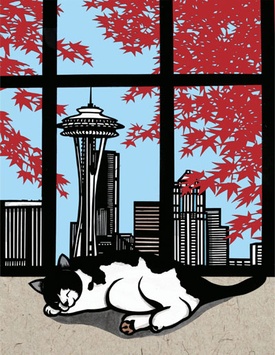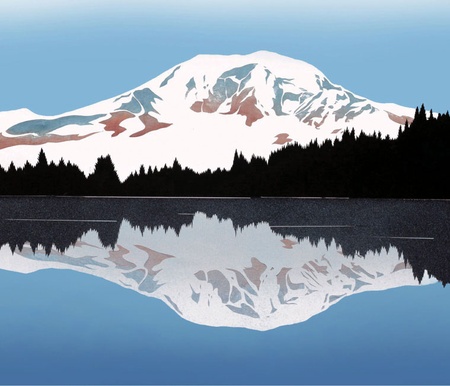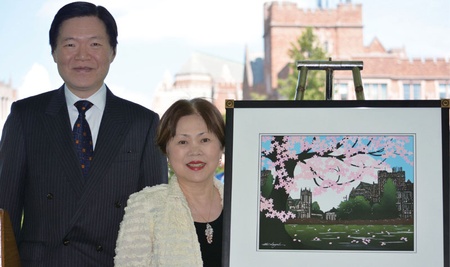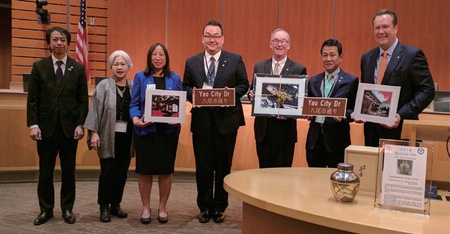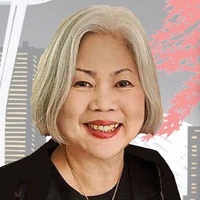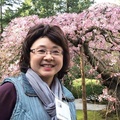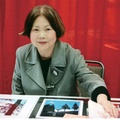Creating works with a "customer first" approach
Aki emphasizes that the most important thing in creating art is the "customer" who will buy it, and he never forgets to be grateful. One year, a woman ordered an original work at the Bellevue Arts Museum's art fair. After her child finally graduated from college and she was able to afford it, she decided to buy Aki's painting, which had been her dream.
"I was so happy that I gave them a lot of extra gifts as a celebration gift (laughs). I was grateful, wasn't I? Unlike food, art is something you don't really need. I make art with that feeling of gratitude."
Although he is a popular artist, his humble attitude is impressive. "After I create a work, I look at it after two or three days. Then I notice something strange in it. There are many paintings that I think, 'I can't show this to people!' I love my work, but I have a mindset that I shouldn't be conceited or satisfied."
After creating a few paintings, there comes a time when I hit a wall. If I belittle my own work, my son scolds me, saying, "That's not true. There must be some customers who think this is good."
"I often worry about whether my paintings are good enough, or that I haven't improved at all. But whether I'm making dinner or doing something else, somewhere in the back of my mind I'm always thinking about my next painting. I just keep on going, keep on going, make something better next time, and make my customers happy, and that's all I ever do."
He has always kept going, knowing that if he stops, it's over. "I really like painting the moon. Looking at the scenery of the trees as the moon begins to rise, I used to say while driving, 'I want to cut a picture like this someday,' and recently, when we see the night view, my son says, 'It looks like Mom's papercutting.' I think I've become able to cut pictures like this."
The challenge as an artist
In 2016, Aki participated in the project for the exhibition "Seattle's Hunt Hotel" organized by the Japanese Cultural and Community Center of Washington (JCCCW). The project uncovered the history of the period from 1945 to 1959, when Japanese Americans who returned from internment after World War II named the building of the Seattle Japanese Language School (the oldest Japanese language school in the United States, founded in 1902, and now the Seattle Japanese Language School) in Japantown as the Hunt Hotel and used it as a temporary residence. Since many of the photographs from that time have been lost, Aki used her papercuts to recreate the atmosphere, based on the testimonies of Japanese Americans who actually lived there.
"Because I don't know what life was like back then, it's difficult to draw a certain picture. First of all, I don't know what they were wearing. Even the hats they wore were different to those worn by people today. But if you look around, you'll find quite a few family photos. What's more, there are no documents showing scenes from their daily lives. I had to sketch over and over again." The works in the Hunt Hotel exhibition have been compiled into a book. "The moment I smell the scent of a new book, I'm filled with a sense of fulfillment that I'm glad I did it."
Aki says that she likes challenging things, and adds that most artists have that kind of personality to some extent.
"When I was asked which of my works I liked best so far, I answered 'the next, next one.' When Picasso was asked the same question, he said 'the next one.' Anyone who creates something always has the desire to do better next time. That's why I tried to imitate Picasso. It's difficult to try new things, though," she says with a laugh.
How has his work been during the COVID-19 pandemic? "It's pretty much the same. Since living under COVID-19, my drawings haven't gotten worse, and it hasn't become any harder to draw. If anything, I've taken this opportunity to try to create more."
Art is all he has. His enthusiastic mind is always full of thoughts about his works. He uses the X-ACTO No. 11 knife for his paper cutting. "I feel uncomfortable if I don't move my fingers with a knife for even five minutes once a day." While he is creating, he likes to listen to jazz, and more recently, various readings on his smartphone. "A friend gave me a Yoshimi Tendo CD, and I listened to it while cutting, but it didn't suit me (laughs)."
Aki says that she is really enjoying life right now. "I'm happy that I can enjoy what I've done and learned every day. I want to keep doing it like this."
* * * * *
Aki Sogabe : Born in Shizuoka Prefecture. Currently living in Bellevue. After moving to the US in 1978, she began working as a professional artist. Her work is exhibited in over 30 public schools in Washington State, and she has also created many public art pieces, such as the murals at Pike Place Market and the steel tower at the entrance to the Seattle Uwajimaya store. She has been selected for the Bellevue Arts Museum's Art Fair for 37 consecutive years since her first entry in 1983 (the 2020 event was canceled due to the COVID-19 pandemic). She has had a "Paper Cut of the Month" column in the sister paper, North American Post , since 1998. www.akisogabe.com
*This article is reprinted from Seattle lifestyle magazine Soy Source (February 21, 2021).
© 2021 Hitomi Kato / Soysource


